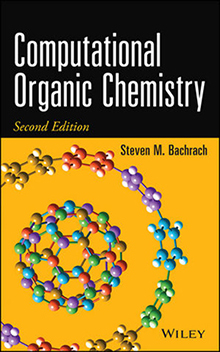The second edition of my book Computational Organic Chemistry has finally been published. The book is available directly from the publisher (Wiley) or from Amazon.

The book web page (comporgchem.com) has been largely updated to reflect the new content: the complete Table of Contents is available as are links to all of the citations. I hope to have all of the molecules added to the web site soon. (All of the materials associated with the First Edition of the book are still available through this same site.)
You’ll notice the great cover for the Second Edition. The image is of the molecular complex designed by Iwamoto and co-workers,1 which I blogged about in this post. The image was prepared by my sister Lisa! (You can see more of her work here.)
The book contains a lot of updated materials along with a great deal of new sections and chapters. The next couple of blog posts will go into some detail about what is new in the Second Edition.
I do want to thank all of the commenters to my blog for their encouragement towards both maintaining this blog service and writing the Second Edition. The many comments helped inform my selections of new materials to include in the new edition.
I hope you enjoy the book and as always I welcome any and all comments and feedback!
References
(1) Iwamoto, T.; Watanabe, Y.; Sadahiro, T.; Haino, T.; Yamago, S. "Size-Selective Encapsulation of C60 by [10]Cycloparaphenylene: Formation of the Shortest Fullerene-Peapod," Angew. Chem. Int. Ed. 2011, 50, 8342-8344, DOI: 10.1002/anie.201102302

Steven Wheeler responded on 14 Apr 2014 at 8:12 pm #
Congratulations on the new edition! My copy is on its way.
Fabio Pichierri responded on 09 Jan 2015 at 11:02 pm #
I own both editions of the book which can be highly recommended to both students and professionals. On June 10-th (2014) I reviewed the 2-nd edition on Amazon; the review is posted here. Cheers, Fabio
REVIEW of Computational Organic Chemistry (2-nd Edition): The second edition of Bachrach’s book (for comments about the 1-st edition see my older review) is a nice addition to the collection of computational quantum chemistry books which comes with extended and updated chapters along with two brand-new chapters. The new chapters are one about “Computed Spectral Properties and Structure Identification” and another about “Computational Approaches to Understanding Enzymes”. The former is especially important for the identification of natural organic compounds which are extracted from plants or living organisms and do require an identification of their molecular structure using spectroscopic/crystallographic methods – computed spectroscopic properties represent a powerful tool for the identification process because upon comparing them against the experimental data it is possible to assign the correct 3D structure to the novel compound. The latter chapter is useful for those intending to study biological systems with the aid of QM/MM methods. With these methods one can treat the important residues in the active site and the substrate at the QM level while the remaining atoms of the enzyme can be treated at the MM level. On his website, the author maintains a blog with novel information and a lively discussion about the topics treated inside the book. Both students and professionals will benefit from reading this book.